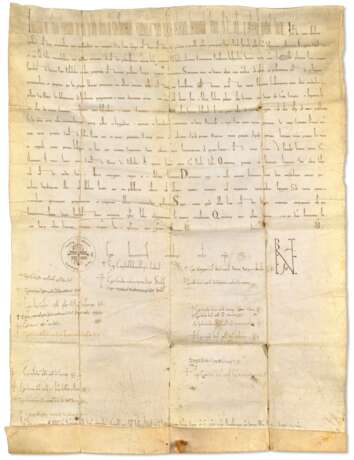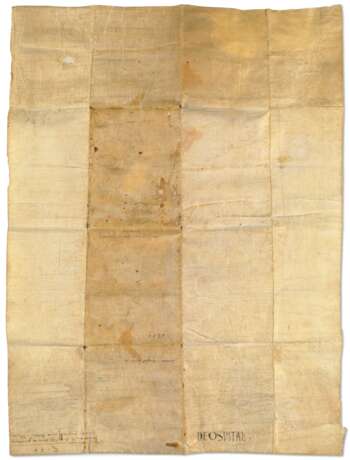ID 519290
Lot 1 | Pope Innocent II (Gregorio Papareschi, died 12 September 1143)
Estimate value
£ 20 000 – 30 000
Manuscript great bull addressed to Silvius, warden of the ‘xenodochium’ or pilgrim hostel adjoining the Lateran Palace, Lateran Palace, Rome, 21 June 1138. Issued by the papal chancellor, Cardinal Aymery de la Châtre, and subscribed by Innocent and 22 cardinals.
In Latin. On vellum, 16 lines in a papal documentary script, on one membrane, 660 x 495mm (a few small splits where folds cross). First line in compressed display script with elongated ascenders, opening word and large initial with decorative pen-flourishing, rota containing Innocent's motto 'adiuva nos deus salutaris noster', 'Bene Valete' monogram; later endorsements on verso. Remnants of seal threads, lead bulla (detached). In a blue solander box.
A grant of protection to a xenodochium or pilgrim hostel: apparently the earliest papal bull to have appeared at auction in at least four decades. Innocent places under papal protection the 'hospital house situated next to our Lateran palace', which had been returned to the use of the poor in the time of Paschal II (pope from 1099 to 1118), and confirms it in all its present possessions. He also confirms to it the chapel of Santa Maria de Oblationario for the burial of pilgrims 'and all the adjacent territory with its garden and olive orchard, from the rock below the palace to the road that leads to the Holy Cross, from the upper road junction to the city walls', as well as the garden between the hospital and the city wall, with other adjacent land, including three turrets in the city wall, and further scattered plots; together with any future gifts. The xenodochium is to remain perpetually for the use of pilgrims and the poor. In addition to Innocent himself, the subscribing cardinals include two future popes: Lucius II (Gherardo Caccianemici dal Orso) and Anastasius IV (Corrado Demetri della Suburra).
The papacy of Innocent II was notably chiefly for his disputed election in 1130, which left an antipope, Anacletus II, in control of Rome until the latter's death in January 1138. The Second Council of the Lateran, in April 1139, was only partially successful in resolving the aftereffects of the schism. In spite of the terms of the present bull, there is little trace in the subsequent historical record of the pilgrim hostel near the Lateran Palace. The document takes the form of a 'great bull', a form which developed in the mid-11th century for the issuing of confirmations of property or charters of protection for religious institutions, as in the present case: they are characterised by the subscription by the pope and a number of cardinals, the rota or wheel bearing the pope's name and motto, the Bene Valete monogram and the datum clause at the foot, giving the name of the issuing official. It is tempting to conclude from the varying hands of the cardinals' subscriptions that they are in autograph.
The present document appears to be the earliest papal bull to have been offered at international auction in at least the last 40 years. ABPC records only four other bulls from the 12th century, the earliest being one of Adrian IV in 1157 (sold at Christie's, 3 December 1997).
| Genre: | Religious genre |
|---|
| Genre: | Religious genre |
|---|
| Address of auction |
CHRISTIE'S 8 King Street, St. James's SW1Y 6QT London United Kingdom | |
|---|---|---|
| Preview |
| |
| Phone | +44 (0)20 7839 9060 | |
| Buyer Premium | see on Website | |
| Conditions of purchase | Conditions of purchase |




